Box jellyfish are a group of highly venomous marine creatures. They are known for their cube-shaped bell. Besides, they belong to long trailing tentacles that can reach up to 10 feet long. These jellyfish are found primarily in the warm coastal waters of the Indo-Pacific Oceans and Australian coasts.
Despite their dangerous reputation, box jellyfish are fascinating creatures that have captured the attention of scientists and nature enthusiasts’ attention.
Let’s learn more about these incredible creatures in this article, from their characteristics to their diet, habitat and lifestyle!
About Box Jellyfish – A Quick Biology
| Parameters | Details |
| Scientific name | Class Cubozoa |
| Kingdom | Animalia |
| Families | 8 families, including Carybdeidae, Chirodropidae, and more |
| Genus | Chironex, Carukia, Malo, Morbakka, Chiropsella, and Tamoya, among others. |
| Class | Cubozoa |
| Order | Carybdeida Claus, Carybdeida Haeckel |
| Species | 50 known including Chironex fleckeri, Carukia barnesi, and Tamoya haplonema. |
| Habitat | Warm coastal waters of Northern Australia, the Pacific and Indian Oceans. |
| Diet | Small fish, crustaceans, and other small invertebrates. |
| Life Span | 8 to 9 months. |
| Geographical range | Warm coastal waters worldwide |
| Weight | Up to 2kg |
| Size | Up to 1 foot in diameter with tentacles up to 10 feet long |
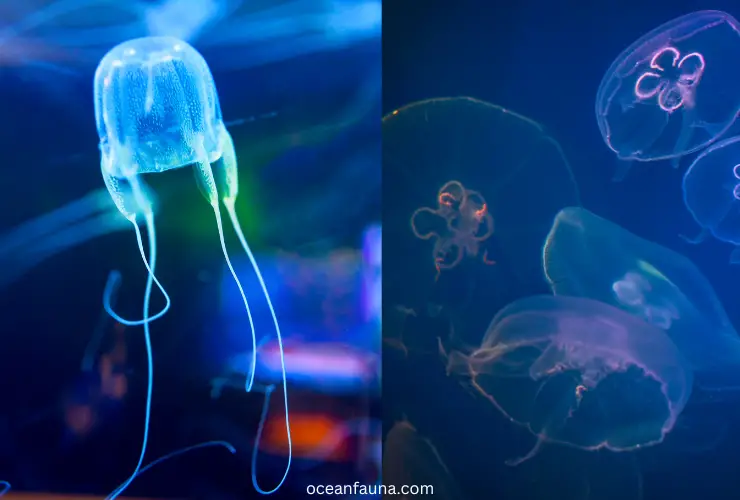
Description and Anatomy of Box Jellyfish
Box Jellyfish have a well-developed visual system that helps them perceive color and navigate through the water. The number and the arrangement of rhopalial nerve cells help them perceive light.
Rhopalia also helps them detect changes in the environment. This jellyfish also have multiple sensory structures, including statocysts, that help them maintain balance.
In terms of anatomy, box jellyfish do not have a brain or central nervous system. Instead, they have a network of nerve cells spread throughout their body which will be explained later in this article.
They also have a simple digestive system, with a mouth located on the underside of the bell-shaped body.
Besides these, you will find a single opening that serves as both a mouth and an anus.
Physical Characteristics / Appearance of Box Jellyfish
Box Jellyfish have a unique and striking appearance, with a cube-shaped bell with a transparent body and a bluish tint. ~ Australian Museum
The bell is divided into four segments, each containing a tentacle cluster. These tentacles are clumped together in 4 clusters, about 60 in number.
They can be up to 3 meters long and contain thousands of tiny, stinging cells called nematocysts. Jellyfish use these stinging cells to capture prey and defend themselves from predators.
The size and appearance of box jellyfish can vary depending on the species. Some are as small as a few millimeters in diameter, while others can reach up to 30 centimeters in diameter.
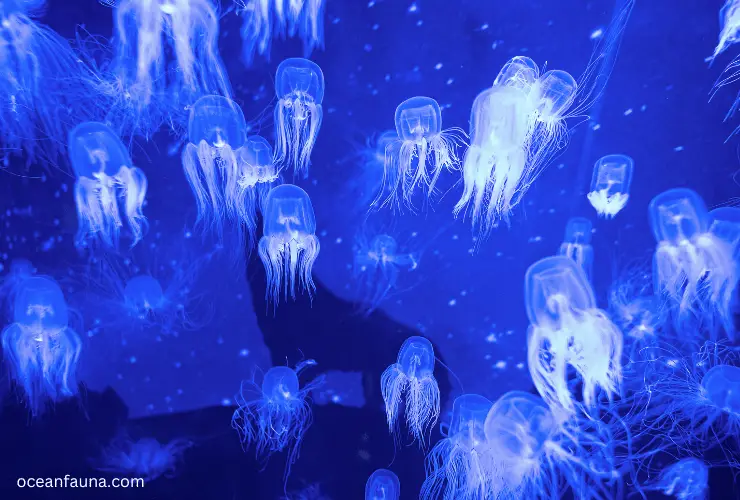
Behavior of Box Jellyfish
Box jellyfish have unique behaviors that enable them to survive and thrive in their ocean environment.
They are active swimmers, capable of propelling themselves through the water using their pulsing bell-shaped bodies. They contract their tentacles from 10 feet long to just 2 feet to prevent resistance while swimming.
Fun Fact: Box Jellyfish can swim at speeds of 4 and a half knots, i.e. 5 miles per hour. This is nearly as fast as an Olympic swimmer! ~ PBS.org
Research has also found that box jellies sleep, a behavior very unusual to jellyfish in general.
Observations have shown that they sink to the bottom of the ocean when it’s dark and sleep, growing about one to two millimeters in length.
Interestingly, these marine stingers (box jellyfish) are known to exhibit phototaxis, which means they are attracted to light and will move toward it.
These animals have a set of 24 eyes, despite which they only show limited visual responses, including phototaxis, shadow responses, and object avoidance responses. ~ National Library of Medicine
Although their visual behaviors are restricted, but these sea wasps rely on vision to navigate through mangrove swamps. They use terrestrial structures visible through the water’s surface to make their way through the swamps.
Habitat, Rrange, and Distribution of Box Jellyfish
These water-dwelling invertebrates are found in warm coastal waters. They are available in the Pacific and Indian Oceans, particularly around Australia, Thailand, and Malaysia.
They prefer shallow water habitats such as estuaries, mangrove forests, and coral reefs but they can also be found in deeper waters.
Different species of box jellyfish have different ranges and distributions.
For example,
- The Australian Box Jellyfish (Chironex fleckeri) is found primarily in the waters around northern Australia and the Indo-Pacific
- The Sea Wasp (Chironex Yamaguchi) is found primarily in the waters around Japan and China.
These marine watery creatures are able to adapt to a range of water conditions and temperatures and are often found in warm waters where their prey is abundant.
These magnificent creatures are known to be more common during warmer months when water temperatures are higher and prey is more plentiful.
Feeding Habits / Diet of Box Jellyfish
These coastal water creatures are carnivorous animals. Their diet primarily consists of small fish, shrimp, and other invertebrates.
They capture their prey using tentacles, covered in thousands of tiny, stinging cells called nematocysts.
When a fish or other prey comes into contact with the tentacles, the nematocysts release toxins that immobilize the prey and allow the box jellyfish to consume it.
These jellyfish species are also known to be opportunistic feeders, meaning they will eat a wide variety of prey when it is available.
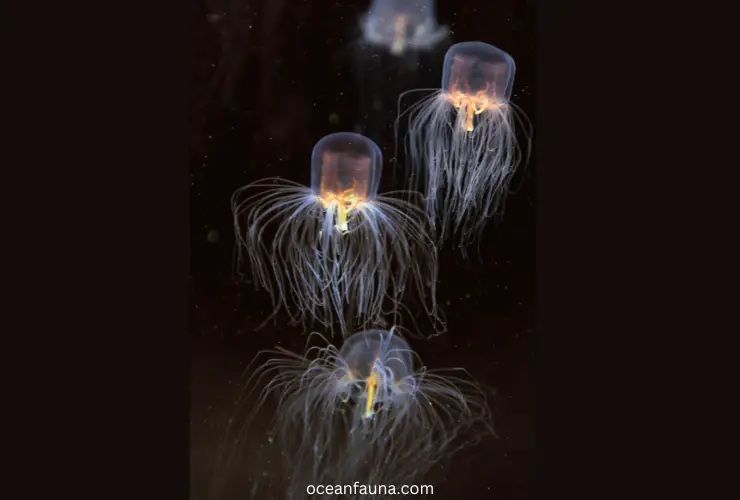
Life Cycle and Reproduction System of Box Jellyfish
Box jellyfish have a unique life cycle that involves both sexual and asexual reproduction. They are capable of reproducing throughout their adult life and can produce hundreds of offspring in a single season.
The life cycle of these jellyfish begins when adult jellyfish release sperm and eggs into the water. The female dies soon after spawning the eggs.
The fertilized eggs develop into small larvae, which eventually settle on the ocean floor and develop into polyps. These polyps can reproduce asexually by budding off new polyps or sexually, by producing medusae (jellyfish).
Did you know when box jellyfish get sexual maturity? Male and female box jellyfish reach maturity at the age of two months. The parents do not contribute to rearing their young.
Cardiovascular and Nervous System of Box Jellyfish
Box jellyfish have a simple nervous system and a basic cardiovascular system.
They have a nerve net that runs throughout their body, which allows them to detect and respond to changes in their environment.
The Central Nervous System CNS) of a box jellyfish is made of two major parts: the rhopalial nervous system and the ring nerve.
The ring nerve surrounds the bell, while the rhopalial nervous system is located within the rhopalia, closely linked with their eyes. Their nervous system is responsible for helping them respond to sensory input received through their eyes.
Box Jellyfish do not have a heart which means they don’t have a properly developed cardiovascular system as humans do. Instead, they absorb oxygen through their skin.
Because they don’t have blood, these creatures don’t need the heart to pump it through their bodies.
Importance of Box Jellyfish in the Ecosystem
These sea wasps or cubozoan (another name for box jellyfish) play an important role in the marine ecosystem as both predator and prey.
As predators, they help to control the populations of small fish and invertebrates, which can have a cascading effect on the entire food chain.
A study conducted on box jellyfish and zooplankton ecosystems suggests that these deadly creatures help regulate the global marine plankton ecosystems, including spatiotemporal dynamics, biomass, and plankton community structure.
This study also showed the sensitivity of zooplankton to the box jellyfish population, demonstrating their importance in regulating the marine ecosystem.
They also serve as prey for larger marine animals, such as sea turtles and some species of fish.
However, the increasing number of box jellyfish blooms in some areas has raised concerns about their impact on human health and the local economy.
In some regions, jellyfish blooms can interfere with fishing and aquaculture operations and pose a risk to swimmers and beachgoers.
On the other hand, research has also shown how important jellyfish blooms are when it comes to providing food supplements to normal deep-sea food webs.
An observational study on jellyfish revealed how quickly jellyfish were scavenged from the ocean floor.
This means that the carbon could reach the deep sea food webs, fueling these systems at a time when food sources to deep-sea ecosystems are decreasing because oceans are warming up.
In addition, box jellyfish are important indicators of the health of the marine ecosystem. Thus, they are known as indicator species. ~ Jellyfishproject.org
Their sensitivity to changes in water temperature, salinity, and other environmental factors make them valuable bioindicators of the health of coral reefs and other marine habitats.
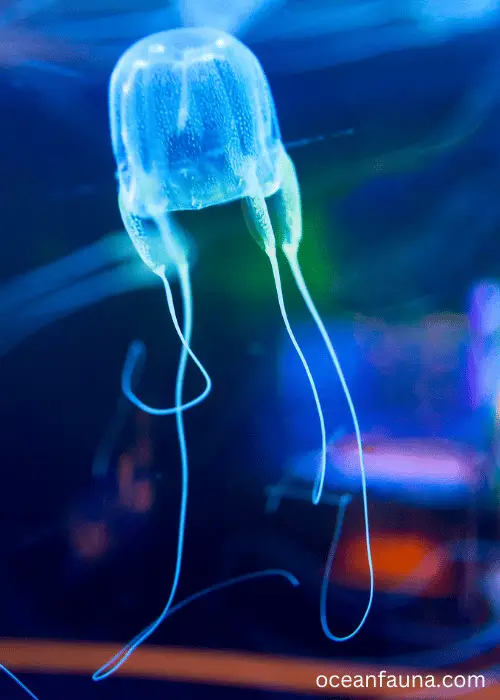
Predators of Box Jellyfish
Despite their potent venom, these marine creatures are known to have a few natural predators.
Box jellyfish’s predators include sea turtles, large fish such as groupers, and some species of birds. These predators can tolerate the venomous stingers of the jellyfish and have adapted mechanisms to protect themselves from being stung.
Some species of fish, such as the barreleye and mirror belly, are also known to feed on jellyfish. They are able to maneuver around the tentacles and feed on the soft body parts of the jellyfish.
Sharks are also known to feed on box jellyfish. For instance, the megamouth shark and the Greenland shark are both predators of box jellyfish.
Relationship between Box Jellyfish and Humans
Box jellyfish have a complicated relationship with humans.
These fascinating creatures attract many tourists and researchers to the tropical waters where they live. On the other hand, their venomous stings pose a significant risk to human health and can even be fatal in some cases.
The deadly animals are responsible for a number of human deaths each year, particularly in regions such as Australia, Thailand, and the Philippines.
Box jellyfish stings can cause intense pain, skin necrosis, and in severe cases, cardiac arrest and death.
The tentacles of this jellyfish will cause excruciating pain and a burning sensation on any human skin that comes into contact with them.
In response to the pain, the victim tends to move around to free his/ her body from the tentacles, and the venom absorption increases, traveling up to the heart at a faster rate.
Thus, it is important for swimmers, divers, and other individuals who may come into contact with box jellyfish to take precautions and avoid contact with these animals.
Do Box Jellyfish Sting?
Yes, box jellyfish do sting, and their sting can be incredibly painful and even deadly.
The venom of these species is the most potent in the world and can cause heart failure and death within minutes.
The sting itself is caused by tiny stinging cells called nematocysts, which are found in the jellyfish’s tentacles. These cells release a neurotoxin that affects the nervous system and can cause paralysis and breathing difficulties.
Other box jellyfish sting symptoms may show up after 20 to 30 minutes of being stung. They include:
- Increased heart rate
- Anxiety
- Sweating
- Nausea or vomiting
- Severe pain in the back, abdomen, or chest
- Breathlessness and trouble breathing
The severity of the symptoms depends on a number of factors, including the species of jellyfish, the amount of venom injected, and the location and size of the sting.
Immediate medical attention is crucial if someone is stung by a box jellyfish, as treatment may involve the use of antivenom and life support measures.
Are Box Jellyfish Rare?
Box jellyfish are not considered rare, as they are found in oceans and coastal waters around the world, particularly in warmer waters.
While some species of box jellyfish are more common in certain areas, such as the Chironex fleckeri in Australia, they can be found in many places throughout the world’s oceans.
Plus, there are over 50 species of box jellyfish out of which 2 are considered deadly. Hence, box jellyfish are not rare.
However, there are certain genera and species of box jellyfish that are not as commonly known as the others. For instance, the Chirodectes maculatus is an extremely rare box jellyfish with only two recorded sightings.
This rare jellyfish is found off the coast of Queensland, Australia, characterized by its unique boxy shape.
Recorded Case of Box Jellyfish: The World’s Most Venomous Creature Takes Another Life
A 17-year-old boy died after being stung by a box jellyfish while swimming in the waters off the coast of Queensland, Australia. Despite immediate medical attention, the young man was unable to recover from the effects of the venom.
Ever since record-keeping began in 1879, there have been about 79 cases of deaths due to box jellyfish. However, it is important to note that many cases go unrecorded which means this is not an accurate number of deaths.
Research suggests that most fatalities occur within four minutes of being stung, leaving the heart in a contracted state.
These venomous creatures are prevalent in Western Australia in November. Thus, people should be extra cautious when visiting beaches at this time of the year.
Box Jellyfish Antidote: Potential Way to Treat the Sting Of the World’s Most Venomous Sea Creature
Scientists have been working on developing an antidote that could help save lives in the event of a sting.
A research team at the University of Sydney has discovered a potential antidote to the venom of the box jellyfish.
The antidote works by preventing the venom from attacking the heart, which is a major cause of death in victims of box jellyfish stings. Basically, they block the venom’s ability to kill cells.
The research team tested the antidote on human heart cells in the lab and found that it was able to protect the cells from venom. However, it is unclear whether the antidote can prevent heart attacks.
The potential for an effective antidote could greatly reduce the risk of death from box jellyfish stings and could even lead to the development of new treatments for other venomous creatures.
A Case Study By a Biochemist: Developing Treatments Against Fatal venom of Box Jellyfish
[Jellyfish almost killed this scientist. Now, she wants to save others from their fatal venom]
Dr. Angel Yanagihara, a biochemist and researcher, has dedicated her life to studying the venom of the box jellyfish and developing treatments for its sting.
Her interest in the box jellyfish species was piqued when she was stung while swimming in Hawaii, an experience that nearly took her life.
Since then, Dr. Yanagihara has been studying the venom of the box jellyfish and working on developing an effective treatment for its sting.
Her research has led to the discovery of a compound that can neutralize the venom and prevent it from causing harm.
Dr. Yanagihara has also developed a sting kit that includes vinegar, which can help stop the spread of the venom and reduce pain. ~ Science.org
She has been working to spread awareness of the dangers of box jellyfish and promote the use of her sting kit.
Through her research and advocacy work, Dr. Yanagihara is hoping to save lives and prevent others from experiencing the same trauma she went through.
Her dedication and determination to find solutions to the dangers of box jellyfish are a testament to the importance of scientific research in protecting human life.
FAQs
How big is the box jellyfish?
The box jellyfish are generally small to medium-sized jellyfish, with their bells ranging from about 1 to 30 centimeters (0.4 to 12 inches) in diameter, depending on the species. Their tentacles can reach up to 3 meters (10 feet) in length.
How many humans are killed by box jellyfish every year?
Box jellyfish are responsible for around 50 to 100 human fatalities annually, primarily in Australia, the Philippines, Thailand, and Malaysia. However, it is difficult to obtain an accurate count since not all incidents are reported or recorded.
Conclusion
In conclusion, the box jellyfish is a fascinating yet dangerous creature found in the ocean waters of the Pacific and Indian Oceans.
Scientists and researchers continue to study box jellyfish in order to better understand their biology and behavior, as well as develop effective treatments for their stings.

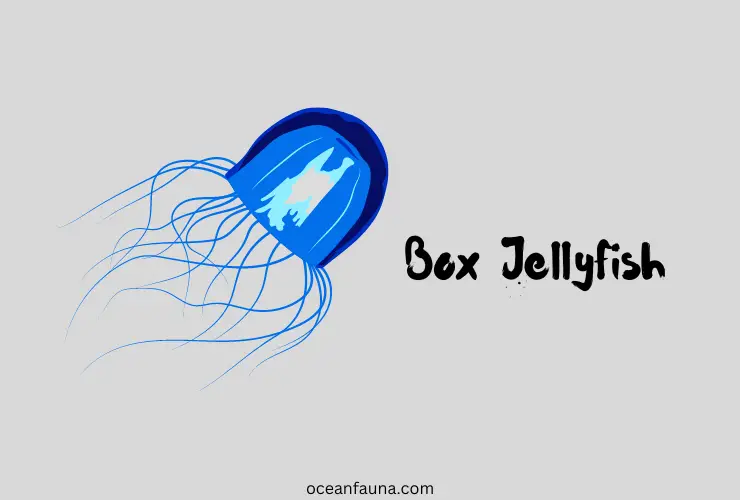
10 thoughts on “Box Jellyfish: Habitat, Diet & Other Facts ”